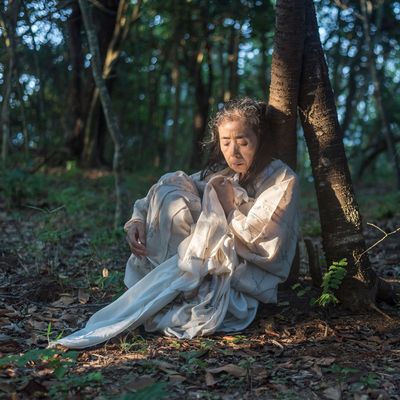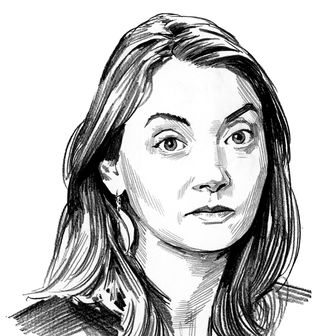
Live, in-person performances are springing up everywhere in New York, crocuses for a spring that’s still probably a year away. Have you seen one? Even when they’re publicized, there’s something a little surreptitious about them: They tend to be out in the experimental reaches, often either dance or performance art — perhaps because that’s where the formal unions aren’t involved. Performances without theaters feel even more ephemeral than they usually do; they seem only tenuously tethered to the earth. Unsurprisingly, given the state of things, that lightness also feels like a doctor’s touch. Is this thought of death painful? Then I’ll just skim my finger over it.
The last weekend in September, I was in Green-Wood Cemetery, watching the dancer Eiko Otake throw herself into a pile of dirt. We sat far away from Otake, well up on a hillside, in one of Green-Wood’s pretty, grassy amphitheaters. The audience needed to be suitably distanced, so we sat next to well-spaced white flags. Mine fluttered from the grave of John Robert Ardery, who died in 1946; his headstone watched over my shoulder. Otake’s brief “Body in a Cemetery” dance was part of her “Body in Places” series, a public mourning performance influenced by her early study with butoh masters. In other installments, she has crept slowly down Wall Street or through Fukushima, her frail ghostliness transparent against big structures of concrete and stone. In Green-Wood, though, she was literally in her element — an artist preoccupied by death, dancing among the dead.
The experience … oscillated. One moment, Otake’s faraway form seemed ravishingly poignant, as she washed a headstone or carried grave-earth in her bodice. But her performance also hinted, as death does, at the absurd. Otake did a lot of dramatic fabric draping during her silent dance, and the rustling Green-Wood seemed to smile as she swung a bit of red cloth portentously around a tombstone. (To keep myself in the proper frame of mind, I thought about how gorgeous Otake’s work looks in photographs, and I tried to see the moment as if I were a lens.) Other parts of the delicate event were incongruous too, particularly the disjunction between the quasi-ritual anti-theater on “stage” and the actual event-management itself. We had checked in with art-world workers wielding clipboards and programs; people accidentally wandering into the performance valley and were chased officiously away. It was the first live, in-person dance I had seen in six months, and I had actually run up to the Green-Wood gates, thrilled out of my mind to see live art again. But watching cemetery visitors amble over a hill just to be kicked out unceremoniously was a part of “normal” I could have skipped. Still, at least it was thematically appropriate. That’s death for you: Booted from a show you didn’t even mean to attend.
The solo performance installation Static Apnea is more oblique — no grave dirt is involved — though the show also has its mind on the beyond. Again, it’s live and in-person (I still tear up when I write that), though the director Christopher McElroen uses sleek environmental design and sensorial intensity where Otake used the natural world and a drifting “is the show even over” time signature. In some ways, McElroen’s compression is the message: Static Apnea’s one-on-one performance takes place in nine minutes and two seconds in a repurposed shipping container, beached between two buildings in Brooklyn. (The piece continues through October 17. The online sign-up makes the show seem sold out; I simply wandered up and was through in under 20 minutes.)
The title refers to holding one’s breath underwater; the show’s length is the women’s record, still held by a woman later lost at sea. McElroen and Julia Watt’s text encourages a perception of this awful coronavirus era as a suspension — from community, from normalcy, from gravity. The single viewer enters Troy Hourie’s design and immediately seems to drop into deep ocean. Once inside the narrow container, we walk alone down a long blue-lit ramp, which descends to a shadowy glass box, where an actor (Jenny Tibbels or Isabella Pinheiro, depending on the day) seems to drift, a scuba diver without her mask. How long, the woman asks, can all of us hold our breath? The crisis crushes our lungs and lives; each person experiences it alone, swimmers in a cave. Can we hold our breaths long enough to survive? To dive down and save our loved ones? A digital clock at our feet ticks by the days … 198 and counting.
I had been having trouble putting into words what these two live performances meant to me until I happened across a panel called “Looking for Language in the Ruins,” a roundtable Zoom with scholar Saidiya Hartman, poet Erica Hunt, and the composer Jerome Ellis. (The trio were participating in a weeklong Black Study Intensive hosted by the University of Pittsburgh’s Center for African American Poetry and Poetics, and the recording is available online.) In each case, the three speakers talked about “making a way out of no way,” in using aesthetics as “fugitive study” and resistance. They were wearily apocalyptic — “the end of the world has been on repeat” — but also energized by their ability to see gaps, disfluencies, and fissures as spaces for imagination. “The end of their world,” said Hunt, “might be the beginning of ours.”
Certainly both A Body in a Cemetery and Static Apnea had carried me briefly out of my own terrors. Despite their sober themes and deep sorrow, they still seemed like tiny escapes: At least I was in another person’s mind for a while, swaying with Otake’s graceful grief or pausing inside McElroen’s held breath. But why did it feel so energizing to think someone else’s thoughts? Hartman and Hunt and Ellis — all so interested in stoppages and breakages — explained it for me. Performances, even when they’re only nine minutes long, are holes in the fabric of daily life. They make a fissure in the accustomed, the everyday, the “normal.” There’s a blue tunnel between two buildings in Brooklyn? There’s a woman burying herself alive? They break reality, which opens the potential for reassembly. A wild possibility hides in each performance: Maybe when you leave, things will be different. “Hope is an aesthetic practice,” said Hunt. “Nothing,” Hartman agreed, her voice ringing with certainty, “need be this way.” The live chat in the webinar went wild as she said it. People wrote it over and over again, as the comment thread streamed upward. Listeners turned her sentence into a prayer and a chant. Nothing need be this way, they wrote. Ashe.
More From This Series
- Living Is Harder: Suffs and Grenfell
- The Wiz Rolls Back Into Town
- Writing Down the Bones: Sally & Tom





